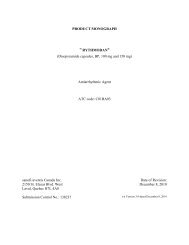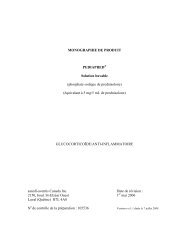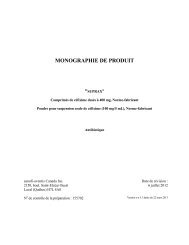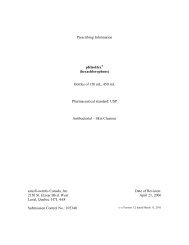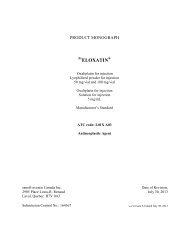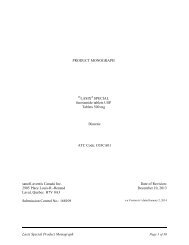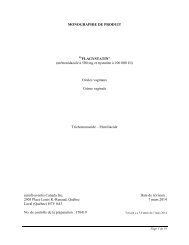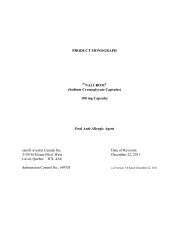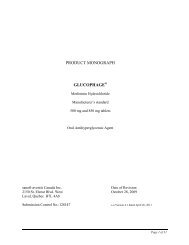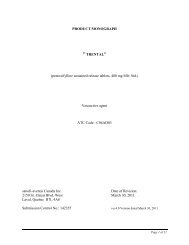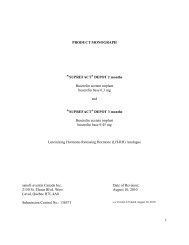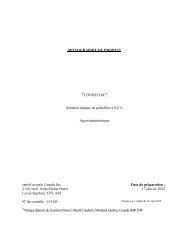Apidra (insulin glulisine) - Sanofi Canada
Apidra (insulin glulisine) - Sanofi Canada
Apidra (insulin glulisine) - Sanofi Canada
Create successful ePaper yourself
Turn your PDF publications into a flip-book with our unique Google optimized e-Paper software.
Antibody Production:<br />
Insulin administration may cause <strong>insulin</strong> antibodies to form. Insulin antibodies are frequently<br />
cross-reactive. Insulin administration may cause the <strong>insulin</strong> antibodies to form. Insulin antibodies<br />
are frequently cross-reactive. In clinical studies, cross-reactive antibodies were observed in both<br />
<strong>insulin</strong> <strong>glulisine</strong> and comparator (<strong>insulin</strong> lispro, regular human <strong>insulin</strong>) treatment groups with<br />
similar percents of increased and decreased titers. There was no correlation between crossreactive<br />
<strong>insulin</strong> antibody concentration and changes in A1c, <strong>insulin</strong> doses, or incidence of<br />
hypoglycemia and the clinical significance of these antibodies is not clear. In theory, the<br />
presence of such <strong>insulin</strong> antibodies may necessitate adjustment of the <strong>insulin</strong> dose in order to<br />
correct a tendency to hyperglycemia or hypoglycemia but has not been found on review of<br />
APIDRA clinical trials.<br />
Intercurrent conditions<br />
Insulin requirements may be altered during illness, emotional disturbances or stress.<br />
Insulin pumps<br />
When used in an external <strong>insulin</strong> pump for subcutaneous infusion, APIDRA should not be mixed<br />
with any other <strong>insulin</strong> or diluted with any other solution. Patients using external pump infusion<br />
therapy should be trained appropriately. Physicians and patients should carefully evaluate<br />
information on pump use in the APIDRA product monograph, package insert, and the pump<br />
manufacturer’s manual.<br />
APIDRA specific information should be followed for period of use, frequency of changing<br />
infusion sets, or other details specific to APIDRA usage, because APIDRA specific information<br />
may differ from general or other <strong>insulin</strong>’s pump manual instructions. Pump or infusion set<br />
malfunctions or <strong>insulin</strong> degradation can lead to hyperglycemia and ketosis in a short time. This is<br />
especially pertinent for rapid-acting <strong>insulin</strong> analogues that are more rapidly absorbed and have a<br />
shorter duration of action. Prompt identification and correction of the cause of hyperglycemia or<br />
ketosis is necessary. Interim therapy with subcutaneous injection may be required (see DOSAGE<br />
AND ADMINISTRATION, Continuous Subcutaneous Insulin Infusion Pump, CONSUMER<br />
INFORMATION, Vials, Continuous Subcutaneous Insulin Infusion Pump, STORAGE AND<br />
STABILITY).<br />
Renal / Hepatic / Biliary / Pancreatic impairment<br />
The pharmacokinetic properties of APIDRA were generally maintained in subjects with renal<br />
impairment. Studies have not been performed in patients with hepatic impairment. As with all<br />
<strong>insulin</strong>s, APIDRA requirements may be diminished due to reduced capacity for gluconeogenesis<br />
Page 8 of 61



